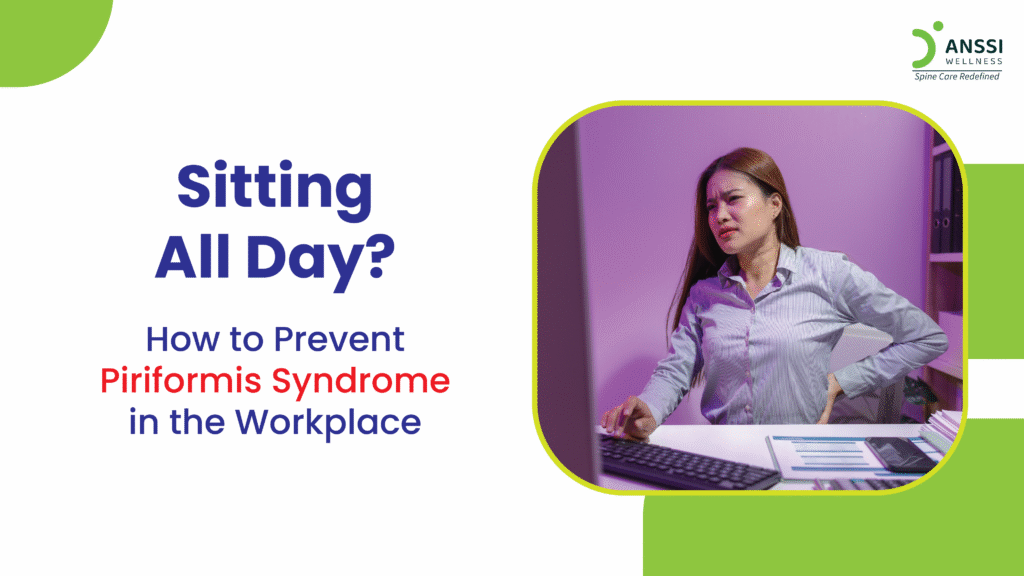In today’s digital age, many of us spend long hours seated at a desk. While this may seem harmless, sitting for extended periods, especially with poor posture, can quietly set the stage for muscle tightness, poor circulation, and even painful nerve compression. One condition that’s increasingly common among desk workers is Piriformis Syndrome.
Let’s understand what Piriformis Syndrome is, why it’s a concern for office workers, and how simple ergonomic changes and daily movement strategies can make a world of difference in preventing it.
What Is Piriformis Syndrome?
Piriformis Syndrome occurs when the piriformis muscle, located deep in the buttock, becomes tight or inflamed and compresses the sciatic nerve. This pressure can cause pain, tingling, or numbness that radiates from the lower back or buttocks down through the leg, a sensation similar to sciatica.
Although Piriformis Syndrome is often associated with athletes, it’s surprisingly common among people who sit for most of the day. Why? Because prolonged sitting weakens the gluteal muscles and tightens the piriformis, reducing mobility and creating muscle imbalances. Over time, this strain on the piriformis can irritate the sciatic nerve and trigger persistent discomfort.
Ergonomic Adjustments to Prevent Strain
The good news is that simple changes to your workspace can help prevent Piriformis Syndrome before it starts. Ergonomics is about designing your environment to support your body, not the other way around.
Here’s how to optimise your workstation:
1. Adjust Chair Height Properly
Ensure your chair is set so that your hips are slightly higher than your knees. This keeps the pelvis in a neutral position and reduces tension on the lower back and hip muscles.
2. Use Lumbar Support
Add a small pillow or lumbar roll to maintain the natural curve of your lower spine. Good lumbar support can prevent slouching, which often contributes to piriformis strain.
3. Keep Feet Flat on the Floor
Do not sit on one foot or cross your legs. Your knees should be at roughly a 90-degree angle, and your feet should be flat. This lessens the pressure on the hip region and aids in the even distribution of your body weight.
4. Align Your Screen and Keyboard
Make sure your monitor is at eye level and keep your keyboard at elbow height. This reduces neck strain and promotes better overall posture, preventing compensatory tightening in the back and hip muscles.
Movement Strategies During the Workday
Ergonomics alone won’t fix everything. Our bodies are made to move, not stay locked in one position for hours. Incorporating short, consistent movement breaks can significantly lower your risk of developing Piriformis Syndrome.
1. Stand Up Every 30-60 Minutes
Use timers or apps to remind yourself to stand, stretch, or take a quick walk. Even a 1-2 minute break from sitting can reactivate your glutes and improve blood flow.
2. Try the Seated Figure-Four Stretch
While sitting, place your right ankle on your left knee and gently lean forward to stretch the piriformis muscle. Hold for 20-30 seconds and switch sides. This stretch can relieve tension and increase hip flexibility.
3. Take Walking Breaks
Instead of sending a message or shouting, walk over to your coworker’s desk. Take calls while pacing or do a few laps around the office during lunch. These small actions keep your muscles engaged.
4. Desk-Based Hip Mobility Drills
Perform simple exercises like leg swings, seated hip rotations, or standing side lunges to keep your hips mobile and the piriformis relaxed. These can be done subtly at your desk without drawing too much attention.
Creating a Healthier Workspace Culture
Preventing workplace-related injuries like Piriformis Syndrome isn’t just an individual effort; it’s something that can be encouraged throughout the office environment.
Here are a few ways to create a movement-friendly culture:
- Encourage Walking Meetings: Not every meeting needs a boardroom. Walking meetings are a great way to stay active, boost creativity, and avoid prolonged sitting.
- Use Movement Reminders in Team Chats: Send regular email reminders suggesting simple stretches or posture checks. A fun, team-based movement challenge can also boost engagement and wellness.
- Provide Access to Ergonomic Tools: Standing desks, supportive chairs, or even office yoga sessions can promote awareness and support employees in maintaining their health.
- Lead by Example: If you’re a team leader or manager, demonstrate that taking short breaks or adjusting your posture is not only acceptable but encouraged.
About ANSSI:
ANSSI Wellness focuses on improving the quality of life for patients suffering from spinal issues, aiming to provide relief where other conventional treatments have failed. Through advanced non-surgical spinal decompression treatment, ANSSI is committed to helping patients avoid surgery and recover in a safe, effective, and compassionate environment.
Connect with ANSSI Wellness on LinkedIn, Instagram, and Facebook for expert guidance.




